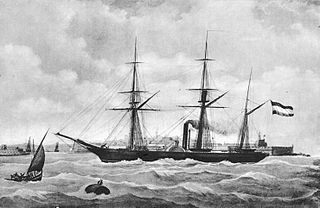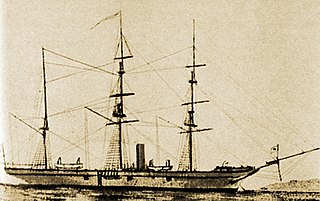 W
WAsahi Maru (旭日丸) was a western-style sail frigate, constructed on orders the Tokugawa shogunate of Bakumatsu period Japan by Mito Domain in response to the Perry Expedition and increasing incursions of foreign warships into Japanese territorial waters. She was built from 1854 to 1856 on land adjacent to Mito Domain’s Edo residence at a site which later became IHI Shipyards.
 W
WBanryū was a ship of the Tokugawa Navy, and following the collapse of the shogunate, was operated by Tokugawa loyalists under the Republic of Ezo during the Boshin War in Japan. An armed iron screw yacht, she had a length of 41.8 metres, a breadth of 5.45 metres, a draught of 3.23 metres, and weighed 370 tons. She was armed with four 12-pounder bronze cannons.
 W
WChiyoda was a gunboat of the Tokugawa Navy, and Japan's first domestically-built steam warship. She was a 3rd class wooden gunboat and laid down May 7, 1861, and launched July 2, 1863 by the shipbuilder, and future industrial giant, Ishikawajima.
 W
WChōyō Maru was an early sail and screw-driven steam corvette. She was ordered by the Tokugawa shogunate ruling Japan during the Bakumatsu period from the Netherlands and served as a training vessel, and subsequently served with the nascent Imperial Japanese Navy during the Boshin War. She was lost in combat during the Naval Battle of Hakodate Bay.
 W
WSMS Danzig was a paddle corvette of the Prussian Navy. She is most notable for her role in the Battle of Tres Forcas in 1856. She was later decommissioned from the Prussian Navy and served in the navy of the Japanese Tokugawa shogunate as the Kaiten from 1864 until 1869, and then briefly with the breakaway Ezo Republic until her destruction later the same year.
 W
WHōō Maru was a western-style sail frigate, constructed by the Tokugawa shogunate of Bakumatsu period Japan in response to the Perry Expedition and increasing incursions of foreign warships into Japanese territorial waters.
 W
WSMS Danzig was a paddle corvette of the Prussian Navy. She is most notable for her role in the Battle of Tres Forcas in 1856. She was later decommissioned from the Prussian Navy and served in the navy of the Japanese Tokugawa shogunate as the Kaiten from 1864 until 1869, and then briefly with the breakaway Ezo Republic until her destruction later the same year.
 W
WTakao Maru (高雄丸) or Kaiten No.2 was a steam warship of the former navy of the Tokugawa shogunate during the Boshin War of 1868-1869.
 W
WKaiyō Maru was one of Japan's first modern warships, a frigate powered by both sails and steam. She was built in the Netherlands, and served in the Boshin War as part of the navy of the Tokugawa shogunate, and later as part of the navy of the Republic of Ezo. She was wrecked on 15 November 1868, off Esashi, Hokkaido, Japan.
 W
WKankō Maru was Japan's first steam-powered warship. It was presented to the Tokugawa shogunate ruling Japan during the Bakumatsu period as a gift from King William III of the Netherlands to assist Janus Henricus Donker Curtius, head of the Nederlandsche Handel-Maatschappij in Japan in his efforts to establish formal diplomatic relations and the opening of Japanese ports to Dutch merchant vessels.
 W
WKanrin Maru (咸臨丸, Unyielding) was Japan's first sail and screw-driven steam corvette. She was ordered in 1853 from the Netherlands, the only Western country with which Japan had diplomatic relations throughout its period of sakoku (seclusion), by the shōgun's government, the Bakufu. She was delivered on September 21, 1857, by Lt. Willem Huyssen van Kattendijke of the Dutch navy. The ship was used at the newly established Naval School of Nagasaki in order to build up knowledge of Western warship technology.
 W
WSan Juan Bautista was one of Japan's first Japanese-built Western-style sailing ships. She crossed the Pacific in 1614. She was of the Spanish galleon type, known in Japan as nanban-sen.
 W
WShōhei Maru (昇平丸) was a sailing frigate constructed on orders of the Tokugawa shogunate of Bakumatsu period Japan by Satsuma Domain in response to the Perry Expedition and increasing incursions of foreign warships into Japanese territorial waters. She was built from 1853 to 1854 at Sakurajima in what is now Kagoshima Prefecture. Shōhei Maru should not be confused with the World War II passenger/cargo vessel of the same name, sunk by the submarine USS Spadefish off of Korea.